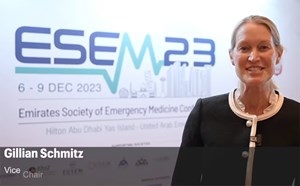
Cases that Count: Using FOCUS (Focused Cardiac Ultrasound) to identify an atrial myxoma in the Emergency Department
Chief complaint: Shortness of breath and chest pressure
Clip 1: https://www.youtube.com/watch?v=9PE6uQeQfj8
Clip 2: https://www.youtube.com/watch?v=Mrlx09bJQV4
Questions:
- What are the significant findings in the ultrasound images?
- What is the differential diagnosis of a left atrial mass? How can this pathology result in right heart failure?
- How did FOCUS affect our patient’s clinical course?
Case Presentation:
A 36-year-old undomiciled male with a history of treated hepatitis C and former intravenous drug use (IVDU) presented to the emergency department (ED) with three days of worsening dyspnea and substernal chest pressure with exertion. He had been released from prison one week prior and denied having any exercise intolerance while incarcerated. Since his release, however, he could not walk more than half a block without dyspnea. He also endorsed three days of substernal, nonradiating, pressure-like chest pain which was worse with exertion. He denied syncope, cough, fevers, chills, nausea, vomiting, or focal weakness.
He was seen in the ED five days prior for ankle pain. At that time, he had mild leg swelling with a negative ankle x-ray and was discharged. He re-presented two days later with persistent leg swelling, tachycardia to 122, and hypoxia to 90% at triage. The ED team at that visit recommended blood work and a computed tomographic pulmonary angiogram (CTPA) study, but the patient refused treatment and left against medical advice (AMA).
At current presentation, he was afebrile with the following vital signs: HR 100; BP 123/80; RR 24; SpO2 94% on room air. He was well-appearing, conversant, and in no acute distress. Physical exam findings were significant for faint bibasilar lung crackles, a 2/6 systolic murmur, and trace bilateral leg edema. He had no jugular venous distension or calf tenderness.
His initial labs were significant for an elevated BNP of 1137, d-dimer of 972, and a mildly elevated troponin-I of 0.1 ng/ml. He was agreeable to undergo a CTPA to evaluate for potential pulmonary embolism during this current visit. While he was waiting for his CT scan, a focused cardiac ultrasound (FOCUS) was used to evaluate the patient at the bedside.
Role of Focused Cardiac Ultrasound
FOCUS is frequently used by non-cardiologist providers in the ED to guide immediate management of chest pain, shock, trauma, and other common presenting complaints.1 FOCUS can specifically evaluate for the presence or absence of pericardial effusion, global estimate of systolic ejection fraction, and right ventricular dilation resulting from acute or chronic right heart strain. FOCUS aids in clinical decision making and increases emergency physician confidence in disposition. One study conducted found that Emergency Physicians were three times more confident regarding diagnosis, seven times more confident regarding treatment, and three times more confident regarding disposition decision-making after using real time FOCUS in the ED.2 In penetrating trauma, early use of FOCUS has been found to decrease the time to diagnose cardiac injury and increase survival when compared to patients who did not undergo FOCUS in the ED.3 The American Society of Echocardiography and the American College of Emergency Physicians released a joint consensus statement in 2010 supporting the critical importance of FOCUS in the practice of the emergency physician.4
Answers to Questions:
1. What are the significant findings in the ultrasound clips?
The main indication for FOCUS was to evaluate for evidence of RV strain which would support the working diagnosis of pulmonary embolism. However, what was visualized instead was a large, hyperechoic mass in the left atrium with the characteristic “mitral plop” protruding into the left ventricle. Best seen on the apical 4 chamber view, the large mass is seen “plopping” into the left ventricle with each mitral valve opening. There is also evidence of right heart strain and right failure seen in the images, as evidenced by the bowing of the septum and right atrial and ventricular dilation.
2. What is the differential diagnosis of a left atrial mass? How can this pathology result in right heart failure?
Primary cardiac tumors are exceedingly rare and the differential for a left atrial mass is broad. Our bedside differential for this left atrial mass included tumor (primary or metastatic), large mitral valve vegetation (especially given our patient’s IVDU history), or atrial thrombus. Of all primary cardiac tumors, the majority are benign myxomas. Myxomas are more common in women, and three out of four are located in the left atrium.5 Echocardiography (preferentially transesophageal echo) is the gold standard for diagnosis of intracardiac masses.
Left atrial myxomas typically produce symptoms after reaching at least 5 cm in size, with dyspnea as the most frequently observed symptom. Usually these symptoms occur progressively.6 Atrial myxomas have been found to cause release of cytokines such as interleukin (IL)-6 and IL-8, resulting in myocardial tissue inflammation, biventricular hypertrophy and dilation with global ventricular dysfunction, likely accounting for our patient’s clinical findings.7,8
3. How did FOCUS affect our patient’s clinical course?
With the identification of a large hyperechoic mass in his left atrium, we rapidly mobilized our cardiology consultants, expedited an echocardiogram, and admitted him to the intensive care unit. Of note, our patient exhibited a large amount of distrust and fear of the medical system. He was afraid of and did not want a CT scan, but we were able to use FOCUS to reach a definitive diagnosis. Using ultrasound at the bedside also allowed us to involve the patient in his care and show him the mass we were seeing. This enabled him to understand the severity of his condition and motivated him to accept our recommendations. Bedside ultrasound has been shown to increase patient satisfaction in the ED setting, and this case illustrates its importance in involving a patient in their own care.9
Clinical Course:
A transthoracic echocardiogram (TTE) correlated with and better characterized our FOCUS findings showing a large (6.4 cm x 3.4 cm) echogenic mass in the left atrium consistent with an atrial myxoma causing severe obstruction of the mitral valve orifice. TTE also demonstrated a severely dilated right atrium and ventricle with right ventricular hypokinesis and severe pulmonary hypertension.
Cardiothoracic surgery was consulted for definitive intervention. The patient underwent right and left heart catheterization for preoperative planning which were unremarkable. He underwent cardiothoracic operative intervention to remove the left atrial mass, which was confirmed by pathology as a left atrial myxoma.
Using FOCUS in a patient with chest pain or dyspnea can change clinical course. With a PE, the ED provider can find right ventricular dilation. With heart failure exacerbation, one might expect to see decreased ejection fraction, abnormal diastolic function, or multiple B lines. As in this case, a large atrial mass might be unexpectedly discovered that can significantly alter the outcome.
References
- Arntfield RT, Millington SJ. Point of care cardiac ultrasound applications in the emergency department and intensive care unit--a review. Curr Cardiol Rev. 2012;8(2):98-108.
- Levitt MA, Jan BA. The effect of real time 2-D-echocardiography on medical decision-making in the emergency department. J Emerg Med. 2002 Apr;22(3):229-33.
- Plummer D, Brunette D, Asinger R, et al. Emergency department echocardiography improves outcome in penetrating cardiac injury. Ann Emerg Med. 1992 Jun;21(6):709-12.
- Labovitz AJ, Noble VE, Bierig M, et al. Focused cardiac ultrasound in the emergent setting: a consensus statement of the American Society of Echocardiography and American College of Emergency Physicians. J Am Soc Echocardiogr. 2010 Dec;23(12):1225-30.
- Jang KH, Shin DH, Lee C, et al. Left Atrial Mass with Stalk: Thrombus or Myxoma? J Cardiovasc Ultrasound. 2010 Dec;18(4):154-6.
- Reynen K. Cardiac myxomas. N Engl J Med. 1995;333:1610-7.
- Chiariello GA, Bruno P, Colizzi C, et al. Acute heart failure related to a large left atrial myxoma. Proc (Bayl Univ Med Cent). 2018;31(3): 331-3.
- Mankad R, Herrmann J. Cardiac tumors: echo assessment. Echo Res Pract. 2016;3(4):R65–R77.
- Howard ZD, Noble VE, Marill KA, et al. Bedside ultrasound maximizes patient satisfaction. J Emerg Med. 2014 Jan;46(1):46-53.
Stasha O’Callaghan, MD
Marsia Vermeulen, DO, FACEP
NYU Langone Health/Bellevue Hospital Center
New York, NY



